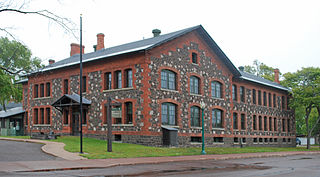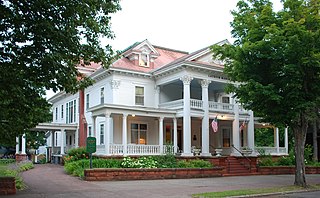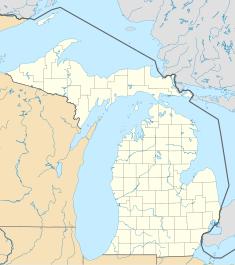
Hancock is a city in Houghton County in the U.S. state of Michigan. It is located across the Keweenaw Waterway from the city of Houghton on the Keweenaw Peninsula. The population was 4,634 at the 2010 census. The city has been consistently ranked as the third-snowiest city in the United States by The Weather Channel.

Calumet is a village in Calumet Township, Houghton County, in the U.S. state of Michigan's Upper Peninsula, that was once at the center of the mining industry of the Upper Peninsula. Also known as Red Jacket, the village includes the Calumet Downtown Historic District, listed on the National Register of Historic Places (NRHP). The village may itself be included within the Calumet Historic District, a larger area which is NRHP-listed and which is a National Historic Landmark District. It is bordered on the north by Calumet Township, on the south by the unincorporated towns of Newtown and Blue Jacket, on the east by Blue Jacket and Calumet Township, and on the west by Yellow Jacket and Calumet Township. The population was 726 at the 2010 census. Calumet's nickname is Copper Town U.S.A.

The Keweenaw Peninsula is the northernmost part of Michigan's Upper Peninsula. It projects into Lake Superior and was the site of the first copper boom in the United States, leading to its moniker of "Copper Country." As of the 2000 census, its population was roughly 43,200. Its major industries are now logging and tourism, as well as jobs related to Michigan Technological University and Finlandia University.

The Keweenaw Waterway is a partly natural, partly artificial waterway which cuts across the Keweenaw Peninsula of Michigan; it separates Copper Island from the mainland. Parts of the waterway are variously known as the Keweenaw Waterway, Portage Canal, Portage Lake Canal, Portage River, Lily Pond, Torch Lake, and Portage Lake. The waterway connects to Lake Superior at its north and south entries, with sections known as Portage Lake and Torch Lake in between. The primary tributary to Portage Lake is the Sturgeon River.

The Quincy Mine is an extensive set of copper mines located near Hancock, Michigan. The mine was owned by the Quincy Mining Company and operated between 1846 and 1945, although some activities continued through the 1970s. The Quincy Mine was known as "Old Reliable," as the Quincy Mine Company paid a dividend to investors every year from 1868 through 1920. The Quincy Mining Company Historic District is a United States National Historic Landmark District; other Quincy Mine properties nearby, including the Quincy Mining Company Stamp Mills, the Quincy Dredge Number Two, and the Quincy Smelter are also historically significant.

Keweenaw National Historical Park is a unit of the U.S. National Park Service. Established in 1992, the park celebrates the life and history of the Keweenaw Peninsula in the Upper Peninsula of the U.S. state of Michigan. As of 2009, it is a partly privatized park made up of two primary units, the Calumet Unit and the Quincy Unit, and 21 cooperating "Heritage Sites" located on federal, state, and privately owned land in and around the Keweenaw Peninsula. The National Park Service owns approximately 1,700 acres (690 ha) in the Calumet and Quincy Units. Units are located in Baraga, Houghton, Keweenaw, and Ontonagon counties.

This is a list of the National Register of Historic Places listings in Houghton County, Michigan.

Stamp sand is a coarse sand left over from the processing of ore in a stamp mill. In the United States, the most well-known deposits of stamp sand are in the Copper Country of northern Michigan, where it is black or dark gray, and may contain hazardous concentrations of trace metals.

Mason is a small unincorporated community in Houghton County, Michigan that is the remainder of past stamp mill operations at the Quincy Mining Company Stamp Mills. Still standing and mostly occupied are 23 mining company houses, all along M-26. Mason has been dubbed by some locals "shutter town," because each house had its own distinct color of shutter. Most of the homes are painted white, and are of the same type and style.

The Calumet and Hecla Mining Company was a major copper-mining company based within Michigan's Copper Country. In the 19th century, the company paid out more than $72 million in shareholder dividends, more than any other mining company in the United States during that period.

Copper mining in Michigan became an important industry in the 19th and early 20th centuries. Its rise marked the start of copper mining as a major industry in the United States.
The Copper Country strike of 1913–1914 was a major strike affecting all copper mines in the Copper Country of Michigan. The strike, organized by the Western Federation of Miners, was the first unionized strike within the Copper Country. It was called to achieve goals of shorter work days, higher wages, union recognition, and to maintain family mining groups. The strike lasted just over nine months, including the Italian Hall disaster on Christmas Eve, and ended with the union being effectively driven out of the Keweenaw Peninsula. While unsuccessful, the strike is considered a turning point in the history of the Copper Country.

The Calumet Historic District is a National Historic Landmark District that encompasses most of the village of Calumet, Michigan. The district was designated in 1989 for the community's importance in the history of the region's copper mining industry.

The Thomas H. Hoatson House is a house located at 320 Tamarack Street in Laurium, Michigan. It was listed on the National Register of Historic Places in 1994. At 13,000 square feet (1,200 m2), it is the largest mansion in the western Upper Peninsula of Michigan.

The Calumet and Hecla Industrial District is a historic district located in Calumet, Michigan and roughly bounded by Hecla and Torch Lake railroad tracks, Calumet Avenue, Mine and Depot Streets. The district contains structures associated with the copper mines worked by the Calumet and Hecla Mining Company, located along a line above the copper lode, where railroad tracks connected separate mine heads. The Historic District is completely contained in the Calumet Historic District and the Keweenaw National Historical Park. It was designated a Michigan State Historic Site in 1973 and was listed on the National Register of Historic Places in 1974.

The Quincy Mining Company Stamp Mills Historic District is a historic stamp mill located on M-26 near Torch Lake, just east of Mason in Osceola Township. It was listed on the National Register of Historic Places in 2007.

The Quincy Smelter, also known as the Quincy Smelting Works, is a former copper smelter located on the north side of the Keweenaw Waterway in Ripley, Michigan. It is a contributing property of the Quincy Mining Company Historic District, a National Historic Landmark District. The smelter was built in 1898 by the Quincy Mining Company, operating from 1898 to 1931 and again from 1948 to 1971. The smelter was part of a Superfund site from 1986 to 2013.



















